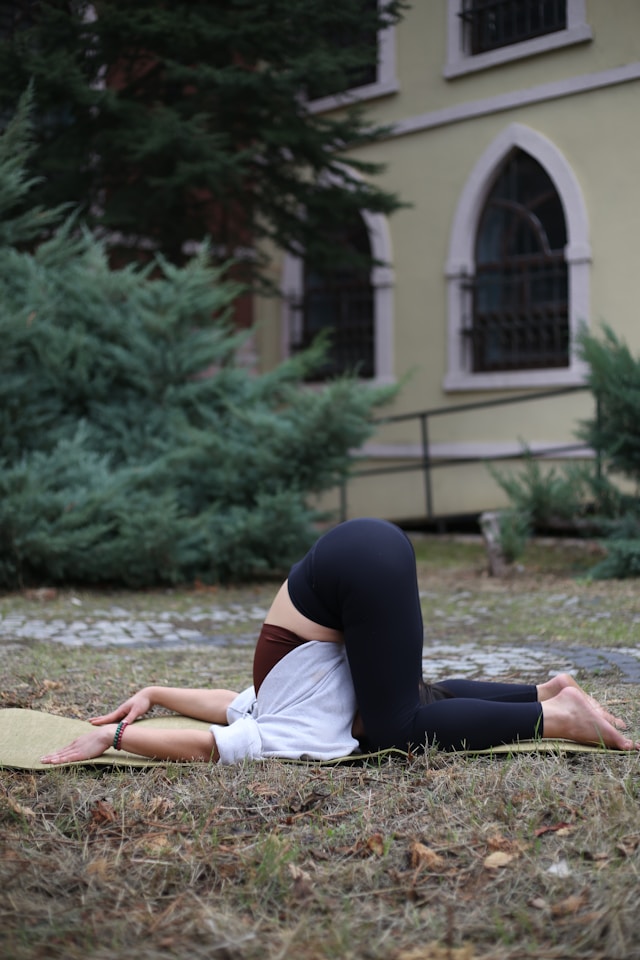Introduction
The journey to a healthier back is not just about alleviating pain; it’s about embracing a lifestyle that enhances spinal integrity through yoga. This article delves into the myriad ways yoga can improve back health, exploring the anatomical and psychological aspects of spinal care. Whether you’re a beginner or an experienced yogi, understanding how yoga impacts the back can improve overall wellness and mobility.
Understanding the Anatomy of the Back
Yoga is known for its benefits to both mind and body and among its many physical benefits, the practice can significantly enhance back health. Understanding the anatomy of yoga can help you appreciate how these exercises support and strengthen the back. Here’s an overview of the key anatomical features relevant to yoga and the back:
1. Spine
The spine is a crucial component of back anatomy, composed of vertebrae, intervertebral discs, nerves, and the spinal cord. Yoga helps maintain spinal health by improving flexibility and strength. Postures (asanas) like forward bends and twists help increase spinal flexibility and alignment while strengthening exercises for the back muscles support the spine.
2. Muscles
Several muscles play critical roles in the health of the back, including:
- Paraspinal muscles: These muscles run alongside the spine and are responsible for the movement and stabilization of the spine.
- Latissimus dorsi: Located in the mid-back, these muscles are involved in arm movement and help with spinal alignment.
- Trapezius: This muscle extends from the neck to the mid-back and supports the movement of the shoulders and neck, which is crucial for many yoga poses.
3. Pelvis
The pelvis acts as a foundational base for the spine. Many yoga poses focus on pelvic alignment, essential for proper posture and reducing strain on the lower back. Poses like the warrior series and bridge pose are beneficial for strengthening the pelvic muscles.
4. Core
Core strength is vital for lower back health, supporting the upper body and maintaining proper alignment and balance. Yoga enhances core strength through poses that require balance and stability, such as plank poses and boat poses.
5. Fascia
Fascia is a band or sheet of connective tissue, primarily collagen, beneath the skin that attaches, stabilizes, and separates muscles and other internal organs. Yoga helps stretch and strengthen the fascia, improving mobility and decreasing pain or discomfort in the back.
6. Joints
Yoga improves joint health by increasing the range of motion and flexibility, which can help alleviate and prevent back pain. Focusing on the hips and shoulders can indirectly benefit the back since these areas are integral to back movements.
7. Nervous System
Yoga benefits the nervous system by promoting relaxation and stress relief, which can reduce tension in the back muscles. Deep breathing and meditation are part of yoga routines that focus on calming the mind, which may help lessen chronic back pain symptoms.
By combining these anatomical insights with regular yoga practice, individuals can enhance their back health, flexibility, and overall well-being. It is always good to be aware of one’s body limits and, if necessary, consult healthcare professionals to tailor yoga practices to individual needs, especially when dealing with back issues.
Related Article: Chair Yoga for Seniors: A Free Guide to Enhanced WellbeingWellbeingticle can provide reaWellbeing beginner-friendly yoga options that are gentle on the spine.
Common Back Issues and How Yoga Can Help
Yoga is often praised for its ability to improve flexibility, strength, and mental well-being. It can also be particularly beneficial for those suffering from common back issues. Here’s a breakdown of typical back problems and how yoga might help alleviate their symptoms.
1. Lower Back Pain
Lower back pain is perhaps the most common back issue, often resulting from poor posture, excessive sitting, or improper lifting techniques. Yoga helps by strengthening the core muscles, enhancing flexibility in the hips and lower back, and improving overall posture. Cat-cow, Bridge, and Child’s Pose can be particularly beneficial.
2. Sciatica
Sciatica involves pain that radiates along the path of the sciatic nerve, extending from the lower back down through the hips, buttocks, and each leg. Yoga can assist by releasing tension in the lower back and hips, alleviating pressure on the sciatic nerve. Poses that can help include the Pigeon Pose and the Seated Spinal Twist.
3. Herniated Discs
A herniated disc occurs when the soft material inside a disc between the spinal bones protrudes, causing nerve irritation and pain. Gentle yoga poses can help promote mobility and reduce spine tension. Forward folds and supine twists can be helpful but should be performed with caution and ideally under the guidance of a yoga therapist.
4. Spondylolisthesis
Spondylolisthesis is when one vertebra slips out of place onto the vertebra below it, which can cause lower back pain. Through yoga, strengthening and stabilizing the core and lumbar spine can help manage this condition. Poses like Plank and Warrior I are beneficial, but avoiding overextending or twisting the spine is essential.
5. General Stiffness and Tension
General back stiffness and tension can occur for various reasons, including stress and lack of movement. Yoga promotes flexibility and reduces stress through both physical postures and breathing exercises. Regular practice of various poses, such as Downward Dog and Cobra, can help increase spinal flexibility and decrease tension.
Related Article: Creating a Yoga Space at Home: This article is useful for readers looking to set up a conducive environment for spinal health yoga practices.
Precautions
While yoga can offer many benefits for back pain relief, practicing safely is essential. Anyone experiencing severe or persistent back pain should consult a healthcare provider before beginning a yoga practice. Moreover, it is crucial to listen to your body and avoid any movements or poses that cause pain or discomfort.
Incorporating yoga into your daily routine can be a valuable part of a holistic approach to managing back issues, promoting not only physical health but also mental and emotional well-being.
Specific Yoga Poses for Low Well-being
Yoga can be an excellent remedy for relieving lower back pain, thanks to its gentle stretching and strengthening exercises. Here are some specific yoga poses that are known to help alleviate discomfort in the lower back:
1. Child’s Pose (Balasana)
This pose is a gentle stretch for the back, hips, thighs, and ankles. It can help relieve pain and tension along the spine, neck, and shoulders.
How to do it:
- Kneel on the floor, touch your big toes together, and sit on your heels.
- Separate your knees about as wide as your hips.
- Exhale and lay your torso between your thighs, extending your arms forward.
- Hold for a few minutes, focusing on deep breathing.
2. Cat-Cow Stretch (Marjaryasana and Bitilasana)
This pair of poses improves flexibility in the spine, relieves tension in the torso, and enhances circulation.
How to do it:
- Start on your hands and knees in a tabletop position.
- As you inhale, arch your back and look up, lifting your tailbone (Cow Pose).
- As you exhale, round your spine towards the ceiling and tuck your head toward your chest (Cat Pose).
- Repeat several times, moving with your breath.
3. Bridge Pose (Setu Bandhasana)
Bridge Pose strengthens the lower back muscles and stretches the spine and neck.
How to do it:
- Lie on your back with knees bent and feet flat on the floor, hip-width apart.
- Press your feet onto the floor, inhale, and lift your hips toward the ceiling.
- Clasp your hands under your body and extend through the arms to help stay on the tops of your shoulders.
- Hold for up to one minute and release with an exhale.
4. Supine Spinal Twist (Supta Matsyendrasana)
This pose can help relieve pain and stiffness in the lower back while promoting mobility.
How to do it:
- Lie on your back, arms out to the sides, palms facing down, in a T position.
- Bring your knees to your chest and let them fall to one side.
- Turn your head in the opposite direction of your knees.
- Hold for a few breaths, then switch sides.
5. Downward-Facing Dog (Adho Mukha Svanasana)
Downward-Facing Dog is a key pose for stretching and strengthening the entire body, with particular benefits for the lower back.
How to do it:
- Start on your hands and knees, with your wrists under your shoulders and your knees under your hips.
- Press into your hands, tuck your toes under, lift your hips, and straighten your legs.
- Keep your head between your arms and focus on pushing your hips up and back.
- Hold for several breaths.
These poses are generally safe and effective for easing lower back pain, but it’s important to move slowly and carefully to avoid any additional strain. Listening to your body is crucial, and it’s wise to consult with a healthcare professional or a trained yoga instructor, especially if your back pain is severe.
Related Article: Yoga Poses to Lose Weight: Connects the benefits of weight loss to reduced strain on the spine, complementing spinal health through yoga.

Yoga Techniques for Strengthening the Spine
Yoga offers a range of techniques that not only help in stretching and relaxing the spine but also in strengthening it. Strengthening the spine through yoga can lead to improved posture, reduced back pain, and enhanced flexibility. Here are some effective yoga techniques and poses that focus on building strength in the spine:
1. Plank Pose (Phalakasana)
Plank Pose is excellent for building core strength, which is essential for spinal support and stability.
How to do it:
- Start in a tabletop position with your wrists under your shoulders.
- Step your feet back to extend your legs fully, coming onto the balls of your feet.
- Engage your abdominals, thighs, and glutes to keep your body straight from head to heels.
- Hold this position for 30 seconds to one minute, focusing on maintaining a robust and engaged core.
2. Cobra Pose (Bhujangasana)
Cobra Pose strengthens the back and shoulder muscles, enhancing the spine’s flexibility.
How to do it:
- Lie face down on the floor with your legs extended and the tops of your feet pressing into the floor.
- Place your hands under your shoulders with elbows close to your body.
- Inhale and gently lift your chest off the floor by straightening your arms, keeping a slight bend in the elbows.
- Engage your lower back muscles and hold for 15-30 seconds.
3. Locust Pose (Shalabhasana)
This pose strengthens the back muscles, which are crucial for spinal support.
How to do it:
- Lie on your stomach with your arms at your sides, palms facing upward.
- As you inhale, lift your head, chest, arms, and legs off the floor.
- Concentrate on lengthening your body from the toes to the crown of your head.
- Hold for 30 seconds to one minute, breathing evenly.
4. Warrior I (Virabhadrasana I)
Warrior I is an excellent pose for strengthening the back muscles, improving balance and stability, and enhancing spine alignment.
How to do it:
- Stand with your feet about 3-4 feet apart.
- Turn your right foot out 90 degrees and your left foot in slightly.
- Raise your arms above your head, palms facing each other.
- Bend your right knee over your right ankle, gently arch your back, and look up.
- Hold for several breaths, then switch sides.
5. Chair Pose (Utkatasana)
Chair Pose works the muscles of the spine and lower back while also building strength in the thighs and ankles.
How to do it:
- Stand with your feet slightly apart.
- Inhale and raise your arms perpendicular to the floor.
- Exhale and bend your knees, trying to take your thighs as nearly parallel to the floor as possible, like sitting in a chair.
- Keep your lower back long and align your knees with the center of your feet.
- Hold for 30 seconds to one minute.
Precautions
While these poses are beneficial for strengthening the spine, performing them correctly is essential to avoid injury. Beginners should consider taking classes with a qualified yoga instructor to ensure proper form and alignment. If you have existing back issues or other health concerns, consult a healthcare provider before starting a new yoga regimen.
The Role of Alignment in Back Health
Alignment in yoga refers to how the body should be positioned in each pose to achieve maximum benefit and avoid injury. Proper alignment is crucial for back health, ensuring the spine is supported correctly during the exercises. Here’s an explanation of the role of alignment in yoga for back health and how it can help prevent and alleviate back issues.
Importance of Proper Alignment
- Prevents Injuries: Misalignment during yoga can lead to strain and overuse injuries. Proper alignment helps distribute weight and stress evenly across the body, reducing the risk of strain on the back and other areas.
- Enhances Effectiveness: Correct alignment increases the effectiveness of each pose by ensuring that the intended muscles and joints are engaged and strengthened or stretched appropriately.
- Improves Body Awareness: Practicing yoga with proper alignment enhances body awareness, making one more aware of postural habits that may contribute to back pain or other issues outside of yoga practice.
- Supports Spinal Health: Proper alignment helps maintain the spine’s natural curves, supporting its integrity and function. This is crucial for those with back problems, such as herniated discs or sciatica.
Fundamental Alignment Principles for Back Health
- Engage the Core: The core muscles support the lower back. Activating these muscles during poses helps protect the back and maintain spinal alignment.
- Lengthen the Spine: Many yoga poses emphasize lengthening the spine, which helps alleviate compression and promotes healthy vertebrae spacing.
- Balance Effort and Ease: Yoga teaches the balance of effort and relaxation in each pose, which is vital for protecting the back from strain. Learning when to push and ease off is crucial in practicing safely.
- Maintain Even Distribution of Weight: Whether standing, sitting, or lying down, distributing your weight evenly helps prevent excessive stress on any part of the body, including the back.
Example Poses and Alignment Tips
- Mountain Pose (Tadasana): Stand with feet hip-width apart and distribute your weight evenly through the soles of your feet. Engage your thighs, tuck your tailbone slightly, and align your head with your spine.
- Triangle Pose (Trikonasana): When entering the pose, ensure your legs are engaged and the pelvis is tucked slightly. Extend the torso from the hip joint over the forward leg, keeping the back long and straight.
- Warrior II (Virabhadrasana II): Align the front heel with the back foot arch, bending the front knee directly over the ankle. Keep the back leg strong and straight, and distribute your weight evenly across both legs.
Yoga Routines to Improve Flexibility
Flexibility through yoga can increase the range of motion, reduce muscle tension, and improve overall mobility. Here’s a yoga routine designed specifically to enhance flexibility:
Warm-Up
Before starting your yoga routine, spend a few minutes warming up the body with gentle movements and deep breathing. This helps prepare the muscles and joints for the stretching exercises ahead. You can incorporate movements like:
- Neck rolls
- Shoulder rolls
- Arm circles
- Side stretches
- Cat-Cow stretches
Yoga Routine for Flexibility
- Sun Salutations (Surya Namaskar): Perform several rounds of Sun Salutations to warm up the entire body and increase circulation. Each round includes a series of flowing movements that stretch and strengthen different muscle groups.
- Forward Fold (Uttanasana): Stand with feet hip-width apart and fold forward from the hips, keeping the spine long. Let the head and neck relax, and hold onto the elbows or shins. Focus on lengthening the spine with each breath.
- Downward-Facing Dog (Adho Mukha Svanasana): From a tabletop position, lift the hips up and back, coming into an inverted V shape. Press the hands into the mat and heels toward the floor while lengthening the spine and legs.
- Seated Forward Bend (Paschimottanasana): Sit on the floor with your legs extended before you. Hinge at the hips and fold, reaching for the feet or shins. Keep the spine long and avoid rounding the back. Hold for several breaths.
- Low Lunge (Anjaneyasana): Step one foot forward into a lunge position, with the knee directly above the ankle. Lower the back knee to the floor and sink the hips. Reach the arms overhead and arch the back slightly, feeling a stretch in the hip flexors and quadriceps.
- Pigeon Pose (Eka Pada Rajakapotasana): From Downward-Facing Dog, bring one knee forward towards the same-side wrist and slide the other leg back, lowering the hips towards the floor. Keep the front foot flexed to protect the knee and hips squared. Hold for several breaths before switching sides.
- Cow Face Pose (Gomukhasana): Sit with legs crossed and stack one knee directly over the other. Reach one arm overhead and bend at the elbow, reaching the hand down the center of the back. Reach the other arm behind the back and clasp hands. Hold for several breaths before switching sides.
- Corpse Pose (Savasana): Finish your routine with Savasana to relax the body and mind. Lie on your back with arms and legs extended, palms facing up. Close your eyes and focus on deep, rhythmic breathing, allowing the body to relax fully.
Cool Down
After completing the routine, take a few moments to cool down with gentle stretching and relaxation poses. This helps to reduce muscle soreness and promote a sense of calm and well-being.
Final Thoughts
Consistency, well-being, and flexibility can be achieved through yoga. Practice this routine regularly, listening to your body and gradually deepening the stretches as your flexibility increases. Remember to breathe deeply and stay present in each pose to experience your practice’s benefits fully.
The Psychological Benefits of Yoga for Back Pain
Yoga is beneficial not only for the physical aspects of back health but also for the psychological ones. It reduces stress and anxiety, which are often linked to chronic back pain. Practices incorporating mindful breathing and meditation can significantly alleviate the psychological factors associated with back discomfort.
Stress Reduction and Back Health
The connection between stress and back pain is well-documented. Yoga’s calming practices, like deep breathing and meditation, can reduce stress levels, thereby minimizing its impact on the back.
Meditation and Mindfulness in Yoga
Incorporating meditation and mindfulness into a yoga practice enhances the psychological benefits, helping to manage pain and improve mental health. This holistic approach effectively treats both the symptoms and causes of back pain.
Yoga Back Classes: What to Expect
For those new to yoga or looking to focus specifically on back health, yoga back classes offer a structured way to learn and practice poses beneficial for the back. Here’s what you can expect when you attend these classes.
Preparing for Your First Yoga Back Class
Newcomers to yoga back classes should prepare by understanding basic poses and bringing the right equipment, like a yoga mat and comfortable clothing. Knowing what to expect can enhance the experience and ensure you get the most out of each class.
Tips for Beginners
Beginners should focus on learning the poses at their own pace and listening to their bodies to avoid strain or injury. Communicating with your instructor about any back issues is essential to tailor the practice to your needs.
Advanced Techniques for Experienced Practitioners
Experienced yogis can deepen their practice by exploring advanced techniques and poses that offer more significant benefits for back health. These might include more complex stretches and props like blocks and straps to enhance the poses.
Integrating Props for Deeper Stretching
Using props in yoga can help achieve deeper stretches and better alignment, which are crucial for back health. Props such as yoga blocks and straps can modify poses, making them more accessible and effective.
FAQs
Is there yoga for back pain?
Yes, specific yoga poses and routines are designed to alleviate back pain. These routines often focus on stretching and strengthening the back, improving flexibility, and reducing muscle tension, which can help relieve discomfort.
What is the name of back yoga?
While there isn’t a specific style of yoga known as “back yoga,” many traditional yoga practices incorporate poses beneficial for back health. These include styles like Hatha, Iyengar, and Restorative yoga, which emphasize alignment, gentle movements, and deep stretching.
How to relieve back pain?
Relieving back pain with yoga involves a combination of poses that stretch and strengthen the back muscles and improve overall body alignment and flexibility. Here are a few effective yoga poses for back pain relief:
Child’s Pose (Balasana): Helps stretch the lower back and hips, relieving tension and pain.
Cat-Cow Stretch (Marjaryasana-Bitilasana): Increases flexibility in the spine and relieves tension in the torso.
Downward-Facing Dog (Adho Mukha Svanasana): Stretches the spine, hamstrings, and glutes, strengthening the dorsal muscles.
Bridge Pose (Setu Bandhasana): Strengthens the lower back muscles and stretches the spine and neck.
Supine Spinal Twist (Supta Matsyendrasana): Relieves stiffness and pain in the back by promoting spinal mobility.
Does yoga help with upper back pain?
Yoga can be very effective in alleviating upper back pain. Poses that open up the shoulders and upper back, such as the following, can help reduce tension and pain:
Cobra Pose (Bhujangasana): Opens the chest and strengthens the upper back.
Eagle Pose (Garudasana): Stretches the upper back and shoulders.
Thread the Needle Pose: Releases tension in the upper back and shoulders.
Conclusion
Yoga is a powerful tool for enhancing back health, providing physical and psychological benefits. Whether you’re dealing with chronic back pain or simply looking to improve your spinal health, incorporating yoga into your routine can lead to significant improvements. Remember, consistency is critical to seeing the benefits of yoga, and incorporating the practices discussed here can help you achieve a healthier, more flexible back.







